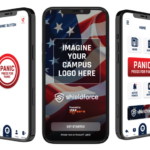There are two important reasons why it’s wise for any academic or medical facility to have at least two (and probably more) emergency notification/mass notification systems:
- Doing so helps them avoid having a single point of failure. If one technology stops working for some reason, the other technology(ies) can hopefully pick up the slack.
- Having multiple systems ensures leaders at a school, college, or hospital can reach more people with alerts during a crisis because the strengths of one technology can compensate for the weaknesses of others.
For example, text alert systems are effective ways to reach on-campus and off-campus students, employees, and parents who have signed up to receive notifications on their mobile phones. However, visitors who aren’t registered for the system or students who have turned off their phones to take a test won’t be reached if a campus only uses this method of emergency notification.
Loudspeaker announcements can quickly reach most people on campus but won’t reach the hearing impaired, people who are listening to loud music on their smartphones, or people who are off campus. Digital signage emergency messages also are instantaneous and can be read by most community members, but won’t reach the sight impaired, as well as individuals who aren’t on campus.
It’s a best practice then for schools, institutions of higher education, and healthcare facilities to have multiple modes of emergency notification. Unfortunately, the results from the 2022 Campus Safety Emergency Notification Survey found that fewer campuses are deploying two or more alert systems than they have in previous years.
Only 64% of respondents to this year’s survey said they use two or more emergency notification systems, with 11% having six or more systems. That’s an eight-percentage point drop from 2020 and 16-percentage point drop from 2019. More than a third of this year’s respondents (37%) said they use only one system (33%) or zero systems (4%) for emergency notification.
It should be noted, however, that this question did not ask if the survey takers with single systems have multiple modes of communication that are integrated (such as email, SMS texting, digital signage, etc.) Hopefully, most of the respondents who said they only use one system have multiple technologies in their systems that are integrated.
But if a campus is only using one technology, it most likely won’t be able to quickly communicate life-saving information during a crisis to many of the students, faculty, staff, clinicians, and visitors on and off campus. The organization also runs the risk of having no ability to communicate should the one technology they are relying on be inoperable for some reason.
More Campuses with Multiple Technologies Are Integrating Their Systems
For those respondents who use two or more mass notification systems, this year’s survey found 9% more have integrated their systems, compared to when we asked about integration in 2019. Sixty percent said all (29%) or some (31%) of their systems are integrated, while another 17% are working to integrate their technologies. That said, nearly one in four (23%) respondents said they aren’t planning on integrating their emergency/mass notification systems.
The increased rate of integration is a positive trend because integrating systems can reduce the time needed to deploy emergency messages, which helps an organization achieve its goal of quickly disseminating potentially life-saving information during a crisis. So, the results from the 2022 Campus Safety Emergency Notification Survey indicate some progress on this issue.
Many Struggle to Reach Hearing-Impaired, Sight-Impaired
This year’s survey asked respondents to rate their level of satisfaction with various aspects of their mass notification systems. Survey takers said they have the greatest satisfaction with their organization’s ability to send alerts to employees, such as administrators, staff members, faculty, and clinicians (3.8, on a scale from one to five, with one being “not satisfied at all” and five being “extremely satisfied”).
Following closely behind is satisfaction with overall emergency notification/mass notification system quality (3.7) and coverage (3.6), which are nearly identical to 2020’s satisfaction level with overall campus emergency notification programs (3.7). The ability to send alerts to individuals who are indoors (3.6) is next, which is a slight improvement over 2020’s rating of 3.47. This year’s respondents rated their ability to send alerts to students at 3.5 and their ability to send alerts to parents/family members at 3.3.
Many said they struggle the most with their ability to send alerts to individuals who are hearing-impaired or sight-impaired (2.5), while they do slightly better with visitors (2.8) and the surrounding community (2.9). Communicating with individuals who are outdoors ranked slightly better at 3.0, which matches 2020’s 3.01 rating of outdoor emergency notification systems.
Nearly two thirds of respondents (64%) use public address (PA) intercoms for their in-building voice communications for mass notification, while about a third use voice evacuation fire alarms systems (33%) and IP-based speaker systems. However, more than one in 10 (12%) don’t use anything for in-building voice communications for mass notification.
Campuses Use Emergency Notifications for a Wide Variety of Situations
Like in 2020, respondents to this year’s survey said they most often use their emergency notification/mass notification systems during situations where there is an active shooter/active assailant (86%). Not surprisingly, nearly that many (78%) use their alert technologies during lockdowns.
Building fires (70%), tornadoes (65%), weapons (62%), and Hazmat situations (58%) are other times respondents said they frequently use their mass notification systems.
However, it’s hit or miss for other types of emergencies or situations. Only 32% of respondents said they use their alert technologies for earthquakes. That lower percentage for this risk is understandable because most areas of the country are not prone to earthquakes.
However, all areas and every type of campus that participated in this survey are vulnerable to IT network disruptions. Despite this, only 29% of respondents use their emergency notification systems during this type of situation.
Frequency of Use, Non-Emergency Use Run the Gamut
How often a campus emergency notification/mass notification system should be used is a topic of hot debate among campus protection professionals. There are also varying opinions on using alert systems for announcements for non-emergencies, such as homecoming rallies, blood drives, ice cream socials, etc.
The decision on how and how often a campus should use a system depends on the technology being considered. Use a system like SMS texting or emergency alert mobile apps too often and for too many non-emergencies, and you run the risk of people ignoring your alerts or opting out of receiving your emergency messages. But, if you don’t use those systems very often, you might not be getting the most out of your technology investment. Also, system administrators might forget how to use the technology.
Digital signage, on the other hand, lends itself to both non-emergency and emergency messaging. In fact, most messaging posted on digital signage should probably not be related to emergencies. If campuses regularly post interesting and helpful non-emergency information on their digital signs, those efforts will train students, staff members, administrators, visitors, clinicians, and faculty to frequently look at campus digital signage for the information they need. Then, when an emergency does happen, the campus can quickly post alerts, which will be noticed by the community because they are accustomed to looking at campus signage.
Email is the emergency notification method most frequently used by respondents. Four in ten use it weekly (11%), several times per week (11%), or daily (18%). Additionally, 85% of respondents use email to convey non-emergency messages. These findings aren’t all that surprising, considering campus email is used by staff members for day-to-day business.
Campuses also use indoor audible communications systems frequently: 29% use them weekly, several times per week, or daily. Furthermore, 32% of respondents said they use this technology for non-emergency announcements.
Twenty-eight percent of survey takers use social media at least weekly, while 61% use it for non-emergency messages. The frequent use of social media for non-emergency communications is a wise move in that it makes the community aware that an organization’s Twitter, Instagram, Facebook, and other social media pages are trusted sources for information. This makes students, teachers, staff, and members of the surrounding community more likely to refer to campus social media during a crisis.
More than one in five (22%) respondents said they use their SMS text alert systems weekly, several times per week, or daily, and 63% use this technology for non-emergency announcements. Hopefully, the nearly two-thirds of respondents using SMS for non-emergencies are being careful not to overuse their systems, which could prompt campus community members to opt-out or ignore important emergency messages.
When it comes to digital signage, 22% use it daily, several times per week, or weekly, while 31% are using it for non-emergency announcements.
82% Test Their Mass Notification Systems Several Times per Year or More
Another new question to this year’s survey is, “How often do you test your emergency notification/mass notification systems?” We included this question because it’s wise for campuses to frequently test their emergency/mass notification systems. Doing so ensures that administrators running the technology know how to use it. Frequent and regular testing also lets campus public safety and emergency management personnel know if the system is working properly. The last thing any campus official wants is to find out during a crisis that their alert system is malfunctioning.
Fortunately, 82% of our survey takers said they test their emergency notification/mass notification systems several times per year or more. However, 18% of respondents are taking a big risk by only testing their systems yearly (14%) or never (4%).
Campus Safety thanks the more than 200 campus protection professionals who participated in this year’s survey. We truly appreciate your input!
Check out the results from some of our previous Emergency Notification Deep Dives:
Survey sponsored by:
















